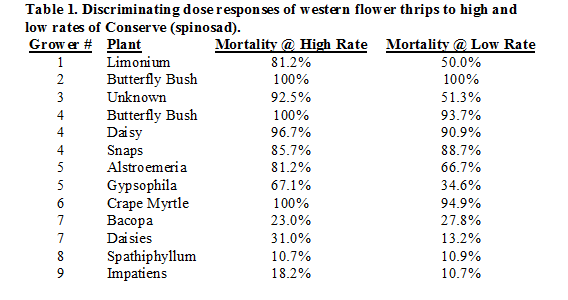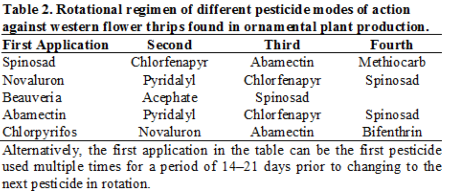Spring 2012: Thrips resistance management
Regional Report for San Diego and Riverside Counties by James A. Bethke
One of the important findings we observed this last year was the identification of western flower thrips populations in San Diego County that are exhibiting high levels of resistance to one of the most effective thrips products on the market, Conserve (spinosad, Dow AgroSciences). We believe it is highly correlated with the amount used on affected properties. In addition, we tried to find alternatives that could be used against a Conserve- resistant population, but with little success.
Our studies conducted at the Center for Applied Horticulture Research in Vista use a discriminating dose assay of Conserve to help determine if growers have resistant populations of thrips. Typically, a suspected insect population will be exposed to varying concentrations of an insecticide to determine the LC50 and LC95 for the population, which is the “lethal concentration” that will kill 50% or 95% of the exposed individuals. The final product is a probit line. A discriminating dose, on the other hand, uses only the high and low concentrations. Quite simply, if the low dose isn’t killing the majority of the insects, there is some tolerance to the pesticide at some level, and if the high dose isn’t working, there is significant resistance present. It’s just a hint of what might be going on, and allows us to study the resistant populations rather than conduct onerous probit line analyses on all populations.
We used the discriminating dose assay on thrips from nine different growers to determine if the thrips populations at their facilities were resistant to Conserve, one of the best products on the market today against thrips. Some growers were able to kill 100% of the thrips at both high and low doses and other growers couldn’t kill more than 20% at either dose. The data in table 1 shows a simplified version of the results.

It is most important to rotate products from different IRAC classes every 14 to 21 days against western flower thrips to catch different generations of thrips with different modes of action. Dr. Ray Cloyd from Kansas State University has suggested the rotations in table 2 as an example of rotational regimens. In addition to the rotational regimens, it is important to hold the most effective products for the times of the year when they are needed the most, so that they will remain highly effective. The persistent uses of the most effective chemicals almost ensure resistance in western flower thrips.

James A. Bethke
Farm Advisor, Nurseries and Floriculture
UC Cooperative Extension San Diego, North County Office
151 E. Carmel St., San Marcos, CA 92078
(760) 752-4715 phone
(760) 752-4725 fax
jabethke@ucdavis.edu
http://cesandiego.ucdavis.edu/












